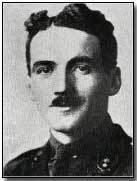Allegiance United Kingdom Name George McElroy | Years of service 1914–1918 | |
 | ||
Nickname(s) "Deadeye", "Mac", "McIrish" Buried at Laventie Military Cemetery, La Gorgue, Nord, France (50°38′10″N 2°46′25″E / 50.63611°N 2.77361°E / 50.63611; 2.77361Coordinates: 50°38′10″N 2°46′25″E / 50.63611°N 2.77361°E / 50.63611; 2.77361) Unit Royal Engineers, Royal Irish Regiment, Royal Garrison Artillery, No. 40 Squadron RAF, No. 24 Squadron RAF | ||
blackhistorymonth dr george mcelroy
Captain George Edward Henry McElroy MC & Two Bars, DFC & Bar (14 May 1893 – 31 July 1918) was a leading Irish-born fighter pilot of the Royal Flying Corps and Royal Air Force during World War I. He was credited with 47 aerial victories.
Contents
- blackhistorymonth dr george mcelroy
- Military career
- Aerial service
- Death in action
- Awards and citations
- References
Military career
McElroy was born at Donnybrook, County Dublin, Ireland to Samuel and Ellen McElroy. He enlisted promptly at the start of World War I in August 1914, and was shipped out to France two months later. He was serving as a corporal in the Motor Cyclist Section of the Royal Engineers when he was first commissioned as a second lieutenant on 9 May 1915. While serving in the Royal Irish Regiment he was severely affected by mustard gas and was sent home to recuperate. He was in Dublin in April 1916, during the Easter Rising, and was ordered to help quell the insurrection. McElroy refused to fire upon his fellow Irishmen, and was transferred to a southerly garrison away from home.
On 1 June 1916 McElroy relinquished his commission in the Royal Irish Regiment when awarded a cadetship at the Royal Military Academy, Woolwich, from which he graduated on 28 February 1917, and was commissioned as a second lieutenant in the Royal Garrison Artillery.
Aerial service
McElroy was promptly seconded to the Royal Flying Corps, being trained as a pilot at the Central Flying School at Upavon, and appointed a flying officer on 28 June. On 27 July his commission was backdated to 9 February 1916, and he was promoted to lieutenant on 9 August. On 15 August he joined No. 40 Squadron RFC, where he benefited from mentoring by Edward Mannock. He originally flew a Nieuport 17, but with no success in battle. By the year's end McElroy was flying S.E.5s and claimed his first victory on 28 December.
An extremely aggressive dog-fighter who ignored often overwhelming odds, McElroy's score soon grew rapidly. He shot down two German aircraft in January 1918, and by 18 February had run his string up to 11. At that point, he was appointed a flight commander with the temporary rank of captain, and transferred to No. 24 Squadron RFC. He continued to steadily accrue victories by ones and twos. By 26 March, when he was awarded the Military Cross, he was up to 18 "kills". On 1 April, the Army's Royal Flying Corps (RFC) and the Royal Naval Air Service (RNAS) were merged to form the Royal Air Force, and his squadron became No. 24 Squadron RAF. McElroy was injured in a landing accident on 7 April; he brushed a treetop while landing. By then he had run his score to 27. While he was sidelined with his injury, on 22 April, he was awarded a bar to his Military Cross. Following his convalescence, McElroy returned to No. 40 Squadron in June, scoring three times, on the 26th, 28th, and 30th. The latter two triumphs were observation balloons. That ran his tally to 30.
In July, he added to his score almost daily, a third balloon busting on the 1st, followed by one of the most triumphant months in the history of fighter aviation, adding 17 victims during the month. His run of success was threatened on the 20th by a vibrating engine that entailed breaking off an attack on a German two seater and a rough emergency landing that left him with scratches and bruises. There was a farewell luncheon that day for his friend "Noisy" Lewis; their mutual friend "Mick" Mannock pulled McElroy aside to warn him about the hazards of following a German victim down within range of ground fire.
On 26 July, his mentor and friend, Edward "Mick" Mannock, was killed by ground fire. Ironically, on that same day, "McIrish" McElroy received the second Bar to his Military Cross. He was one of only ten airmen to receive the second Bar.
Death in action
McElroy's continued apparent disregard for his own safety when flying and fighting could have only one end. On 31 July 1918, he reported destroying a Hannover C for his 47th victory. He then set out again. He failed to return from this flight and was posted missing. Later it was learned that McElroy had been killed by ground fire. He was 25 years old.
McElroy would receive the Distinguished Flying Cross posthumously on 3 August, citing his shooting down 35 aeroplanes and three observation balloons. The Bar would arrive still later, on 21 September, and would laud his low-level attacks. In summary, he shot down four enemy aircraft in flames and destroyed 23 others, one of which he shared destroyed with other pilots. He drove down 16 enemy aircraft "out of control" and out of the fight; in one of those cases, it was a shared success. He also destroyed three balloons.
McElroy is interred in Plot I.C.1 at the Laventie Military Cemetery in La Gorgue, northern France.
